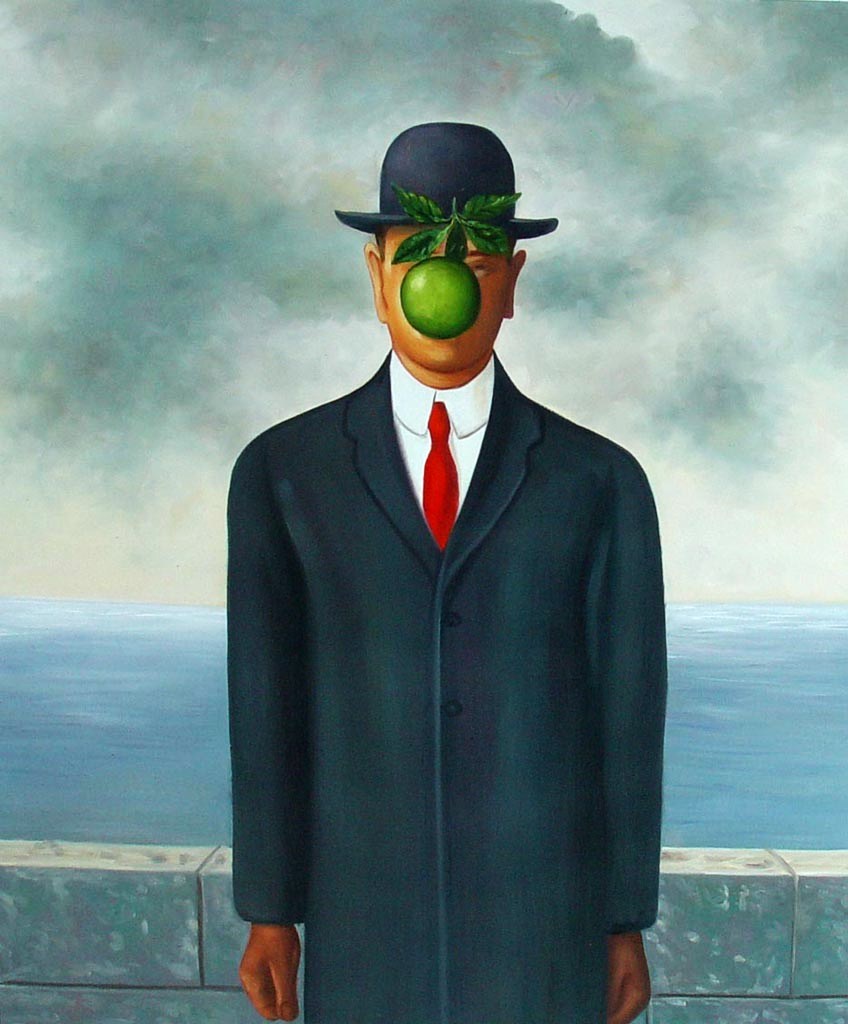This 1964 work by René Magritte is
among the artist's most indelible images, paving the way for innumerable
psychological and philosophical study and artistic imitation (not to mention
innumerable parodies). It's titled Son
of Man, and it is, quite simply, a man whose face is covered by a floating
apple. Both the title and the background
scenery (a short wall opens out to a broad, oceanic landscape and a cloudy sky
behind the man) seem to impart an expansion of ideological context to this
image; and yet, the actual scene is so tantalizingly simple, isn't it? We can almost see the man's face—one of his
eyes peeks through—but it's hidden by this random apple that absurdly floats in
mid-air for seemingly no other purpose than to frustrate us. The artist is here most straightforwardly
playing with the inherent curiosity of the human brain. As viewers, we look to this figure's face and
yet are turned down by such a small thing.
It's as if we could just reach out and pull away the apple, and then
finally be able to see the man's face.
But we can't; and forever the image is painted this way. We don't care to see the apple; and yet that
is, ironically, put before the man. It's
totally absurd, and is intentionally so in order to enact this experiment on
the eye's preference and selectiveness of vision. Our mind chooses to focus on the man and
views the apple as secondary—hey, maybe it's supposed to be a simple still life
of a floating apple into which an intruding figure has stumbled. Regardless, we look to the man for subject
matter and meaning. Meditations such as
this reflect the Surrealist attention to perceptions of normalcy in
society. By adding just such a little,
simple thing as an apple in the right place (or wrong place, I suppose), a
formality within the practice of vision is undermined. In art, a medium of images, we are finally
presented with an artist's denial of an image.
This not only goes against the rules of painting technique but it
maddens audiences to the point of distraction.
Nonetheless, Magritte makes his point, does he not? This seemingly simple painting becomes one of
the hardest images for us to look at and accept in our study of the history of
art, and it has nothing to do with the apple, but rather what the apple
conceals.
And yet, after reading the title,
aren't we left feeling that maybe the apple does
have something to do with the subtle profundity of this image? The mysteriously floating apple becomes a
spiritual symbol of a religious idea, a doctrinal precept lending possible
interpretation to the scene. Is this a
statement on original sin? Does this
unqualified man, in his anonymity, take on the identity of Adam because of his
relation to the apple? Or maybe this is
a projection of our own human blindness—that the curse of the forbidden fruit
stands between ourselves and every other human being when we try to interact
with our fellow man. Inasmuch as
floating apples don't exist in the real world (except, I suppose, on the
International Space Station), maybe this apple isn't a real object at all but
merely a psychological projection of our own subconscious. Or, conversely, what if the apple is in front
of the man's face because that is really all that matters—as if to say that
one's individual struggles with sin or temptation are the only relevant
incidents in the human experience, and none of us can ever really relate, one
human being to another, except within that common context of lineage or
"sonship" to Adam? At any rate,
this Surrealist painting displays in extraordinary simplicity one of the most
vividly contrasting images in Western art history. Isn't it ironic that this produce from the
Tree of Knowledge should in fact conceal knowledge, vision, and interpersonal
relationship? Perhaps art, too, hides
more than it shows; and a painting gets in the way of some imminent reality
that just slightly escapes us.













